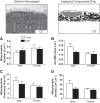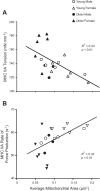Age-related structural alterations in human skeletal muscle fibers and mitochondria are sex specific: relationship to single-fiber function
- PMID: 24790014
- PMCID: PMC4064376
- DOI: 10.1152/japplphysiol.01362.2013
Age-related structural alterations in human skeletal muscle fibers and mitochondria are sex specific: relationship to single-fiber function
Abstract
Age-related loss of skeletal muscle mass and function is implicated in the development of disease and physical disability. However, little is known about how age affects skeletal muscle structure at the cellular and ultrastructural levels or how such alterations impact function. Thus we examined skeletal muscle structure at the tissue, cellular, and myofibrillar levels in young (21-35 yr) and older (65-75 yr) male and female volunteers, matched for habitual physical activity level. Older adults had smaller whole muscle tissue cross-sectional areas (CSAs) and mass. At the cellular level, older adults had reduced CSAs in myosin heavy chain II (MHC II) fibers, with no differences in MHC I fibers. In MHC II fibers, older men tended to have fewer fibers with large CSAs, while older women showed reduced fiber size across the CSA range. Older adults showed a decrease in intermyofibrillar mitochondrial size; however, the age effect was driven primarily by women (i.e., age by sex interaction effect). Mitochondrial size was inversely and directly related to isometric tension and myosin-actin cross-bridge kinetics, respectively. Notably, there were no intermyofibrillar or subsarcolemmal mitochondrial fractional content or myofilament ultrastructural differences in the activity-matched young and older adults. Collectively, our results indicate age-related reductions in whole muscle size do not vary by sex. However, age-related structural alterations at the cellular and subcellular levels are different between the sexes and may contribute to different functional phenotypes in ways that modulate sex-specific reductions in physical capacity with age.
Keywords: aging; mitochondria; muscle ultrastructure; sarcopenia.
Copyright © 2014 the American Physiological Society.
Figures






References
-
- Brierly EJ, Johnson MA, Bowman A, Ford GA, Subhan F, Reed JW, James OF, Turnbull DM. Mitochondrial function in muscle from elderly athletes. Ann Neurol 41: 114–116, 1997 - PubMed
-
- Broskey NT, Greggio C, Boss A, Boutant M, Dwyer A, Schlueter L, Hans D, Gremion G, Kreis R, Boesch C, Canto C, Amati F. Skeletal muscle mitochondria in the elderly: effects of physical fitness and exercise training. J Clin Endocrinol Metab 99: 1852–1861, 2014 - PubMed
Publication types
MeSH terms
Substances
Grants and funding
LinkOut - more resources
Full Text Sources
Other Literature Sources
Medical
Research Materials

